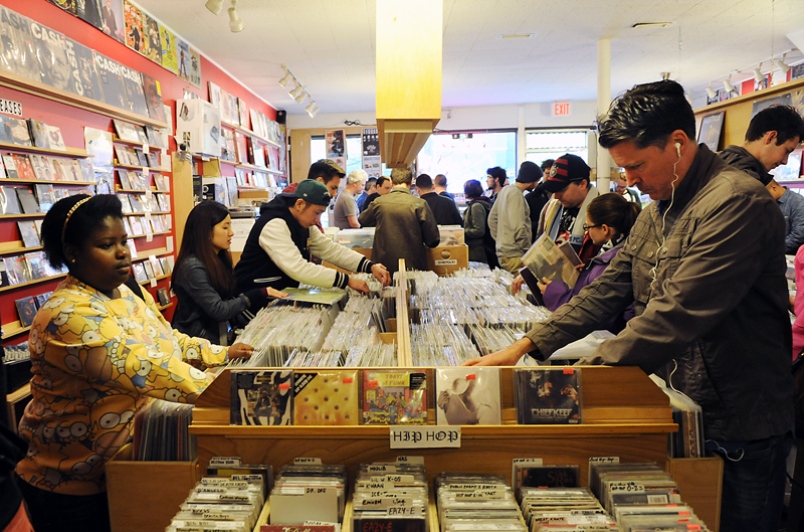Most music fans over the age of 30 can fondly recollect heading to their local record store, browsing the vinyl, cassettes or CDs and making impulse buys on the aesthetics of a physical release alone, but were these bygone era days the golden age of music discovery or do we have rose-tinted glasses on the reflections of our experiences?
In this article, we will cover the pros and cons of the impulse-buying music discovery era before looking into the new ways of music discovery, which are infinitely more cost-effective and environmentally friendly, even if the magic of the tangible experience of heading home with your new potentially favourite record has become lost.
Pros of the Impulse Buying Era of Music Discovery
Tangible Discovery Experiences:
Physical browsing for new music from unknown bands used to provide music fans with a sensory experience that digital platforms struggle to replicate. The tactile feel of flipping through albums and the visual appeal of album art in a record store created a memorable and engaging way to discover music.
Holding an album, admiring its artwork, and reading liner notes create a deeper connection to the music. Physical media artefacts become personal treasures, embodying memories and emotions tied to specific times or events in one’s life. Moreover, the ritual of playing a vinyl record or inserting a CD involves an intentional act of listening that digital streaming often lacks, encouraging a more immersive and focused appreciation of the music.
Artist Revenue & Album Sales
The sale of physical media often resulted in higher per-unit profits for artists and labels, compared to the fractions of a cent earned per stream on most digital platforms today. Furthermore, fans often purchased whole albums rather than single tracks, which benefited artists by promoting a deeper engagement with their work, as well as financially through fuller album sales.
Local Economy Support:
Music stores, especially independent ones, thrived as cultural hubs in communities, supporting local economies and offering music lovers a place to gather and share their interests. In these vibrant spaces, people of all ages and backgrounds could meet, fostering a sense of belonging and community through shared musical interests. Browsing through rows of records offered an immersive experience that encouraged spontaneous conversations and recommendations, leading to the discovery of new artists and genres.
In contrast, today’s digital landscape often promotes a more solitary engagement with music. Streaming services provide convenience and access but lack the interactive, communal atmosphere of record stores. The personal connections once made over album bins are replaced by algorithmic recommendations, leading to a more isolated and less serendipitous experience of music discovery. This shift has diminished the communal aspects of music consumption, making the nostalgic appeal of record stores even more profound for those who remember them.
Cons of Impulse Buying Era
Limited Access and Selection:
The selection was often limited to what was available in the store, which could be constrained by geographical location and store size. This limited fans’ exposure to diverse or international music scenes. The digital age has democratised music production and distribution, allowing independent and niche artists to reach audiences without the need for traditional record labels. This change has enabled many artists to carve out sustainable careers by directly engaging with their fanbase, utilising platforms like Bandcamp, Patreon, and social media for promotion and sales.
Higher Cost:
Physical media costs significantly more than making digital purchases or enjoying music via streaming services. Now, if we’re broke, we don’t have to worry about missing out on new releases, we can stream them for free or for a minimal fee that unlocks access to millions of artists. Archetypes like the ’50-quid-man’ used to help keep the industry afloat by buying a fistful of CDS every month, and while those kinds of consumers still exist, artists and bands can no longer rely on them.
Inefficiency and Environmental Impact:
Producing vinyl, CDs, and cassettes involves physical materials and manufacturing, which have a larger environmental footprint than digital downloads and streaming. During the 1990s and early 2000s, it was common practice for record labels to overproduce physical media anticipating high demand. When sales projections did not pan out, excess stock was often destroyed or discarded.
Digital Era: A New Landscape
Accessibility and Convenience:
Digital music platforms allow instant access to a vast array of music from around the world, which is especially beneficial for niche and emerging artists who can reach a global audience without the need for physical distribution.
Lower Costs and Less Space:
Digital music eliminates the need for physical storage space and is generally cheaper for consumers, allowing more expansive music collections. While many music fans take immense amounts of pride in their music collections, let’s spare a thought for all of the CD buyers who spent thousands on their collections only to grow out of the purchases and realise that the resale value is dire.
Artist Discovery and Diversity:
Love them or loathe them, streaming services and online platforms can offer sophisticated algorithms that help users discover music that aligns with their tastes, potentially introducing them to a wider range of artists and genres than they might encounter in a physical store.
Conclusion
While there are nostalgic and qualitative benefits to the era of impulse buying in music stores, the digital age offers substantial advantages in terms of accessibility, cost, and diversity.
Of course, there is nothing stopping you from heading down to your local independent record store and taking your chance on an artist by the look of the artwork alone; the fact that this has become much less of a music discovery phenomenon proves that the more contemporary modes of music discovery are far better for music fans – even if the big label artists do suffer as a result and need to rely on touring and merchandising more.
Article by Amelia Vandergast



No Comments